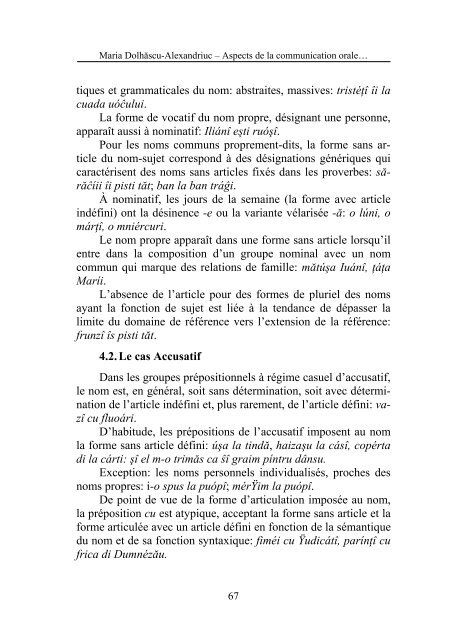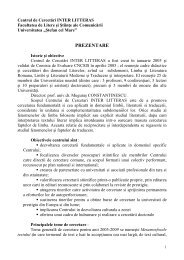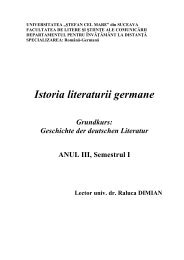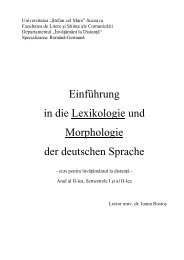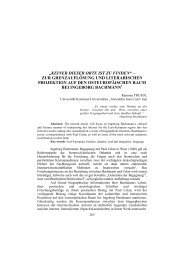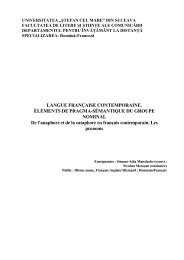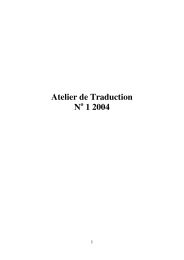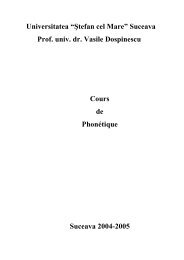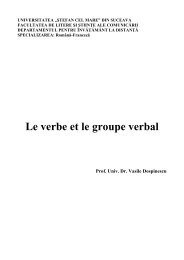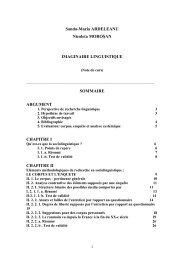Le discours de la francophonie
Le discours de la francophonie
Le discours de la francophonie
Create successful ePaper yourself
Turn your PDF publications into a flip-book with our unique Google optimized e-Paper software.
Maria Dolhăscu-Alexandriuc – Aspects <strong>de</strong> <strong>la</strong> communication orale…tiques et grammaticales du nom: abstraites, massives: tristéţî îi <strong>la</strong>cuada uóĉului.La forme <strong>de</strong> vocatif du nom propre, désignant une personne,apparaît aussi à nominatif: Iliánî eşti ruóşî.Pour les noms communs proprement-dits, <strong>la</strong> forme sans articledu nom-sujet correspond à <strong>de</strong>s désignations génériques quicaractérisent <strong>de</strong>s noms sans articles fixés dans les proverbes: sărăĉíiiîi pisti tăt; ban <strong>la</strong> ban tráĝi.À nominatif, les jours <strong>de</strong> <strong>la</strong> semaine (<strong>la</strong> forme avec articleindéfini) ont <strong>la</strong> désinence -e ou <strong>la</strong> variante vé<strong>la</strong>risée -ă: o lúni, omárţî, o mniércuri.<strong>Le</strong> nom propre apparaît dans une forme sans article lorsqu’ilentre dans <strong>la</strong> composition d’un groupe nominal avec un nomcommun qui marque <strong>de</strong>s re<strong>la</strong>tions <strong>de</strong> famille: mătúşa Iuánî, ţáţaMaríi.L’absence <strong>de</strong> l’article pour <strong>de</strong>s formes <strong>de</strong> pluriel <strong>de</strong>s nomsayant <strong>la</strong> fonction <strong>de</strong> sujet est liée à <strong>la</strong> tendance <strong>de</strong> dépasser <strong>la</strong>limite du domaine <strong>de</strong> référence vers l’extension <strong>de</strong> <strong>la</strong> référence:frunzî îs pisti tăt.4.2. <strong>Le</strong> cas AccusatifDans les groupes prépositionnels à régime casuel d’accusatif,le nom est, en général, soit sans détermination, soit avec détermination<strong>de</strong> l’article indéfini et, plus rarement, <strong>de</strong> l’article défini: vazîcu fluoári.D’habitu<strong>de</strong>, les prépositions <strong>de</strong> l’accusatif imposent au nom<strong>la</strong> forme sans article défini: úşa <strong>la</strong> tindă, haizaşu <strong>la</strong> cásî, copértadi <strong>la</strong> cárti: şî el m-o trimăs ca ŝî graim píntru dânsu.Exception: les noms personnels individualisés, proches <strong>de</strong>snoms propres: i-o spus <strong>la</strong> puópî; mérŸim <strong>la</strong> puópî.De point <strong>de</strong> vue <strong>de</strong> <strong>la</strong> forme d’articu<strong>la</strong>tion imposée au nom,<strong>la</strong> préposition cu est atypique, acceptant <strong>la</strong> forme sans article et <strong>la</strong>forme articulée avec un article défini en fonction <strong>de</strong> <strong>la</strong> sémantiquedu nom et <strong>de</strong> sa fonction syntaxique: fiméi cu Ÿudicátî, parínţî cufrica di Dumnézău.67


